Zebra mussels confirmed in Canisteo Mine Pit in Itasca County

The Minnesota Department of Natural Resources has confirmed a report of zebra mussels in the Canisteo Mine Pit, one of a series of legacy mine pits adjacent to the cities of Bovey and Taconite in Itasca County. The DNR and other cooperating entities are working together to address the zebra mussel infestation and contingency pumping to manage the water levels at the Canisteo.
An angler reported finding numerous zebra mussels on a submerged tree branch while fishing in the mine pit. On September 12, DNR invasive species specialists confirmed the presence of adult zebra mussels in a search of the 1,458-acre pit.
In addition to ecological impacts that zebra mussels have on a waterbody, zebra mussels can also adversely affect recreation and cause expensive damage to equipment such as boat motors and water pumping systems. Of particular relevance to the Canisteo Mine Pit, when pumping and discharging water from a zebra mussel-infested waterbody, the water must first be filtered to eliminate zebra mussel larvae, called veligers, to prevent the spread of invasive species downstream.
Since 2018, the DNR has been working with state agencies, local governments and private entities to address high water levels in the Canisteo Mine Pit complex. In August, the Iron Range Resources and Rehabilitation Board approved $710,000 for contingency pumping to manage water levels until a permanent outlet solution is in place. The DNR is working to implement a filtration system to prevent the release of zebra mussels during this contingency pumping. The DNR will continue to work closely with state and local partners to ensure water levels do not adversely affect surrounding communities while also complying with invasive species prevention requirements.
Whether or not a lake has any invasive species, Minnesota law requires people to:
- Clean watercraft, trailers and equipment to remove aquatic plants and prohibited invasive species.
- Drain all water and leave drain plugs out during transport.
- Dispose of unwanted bait in the trash.
- Never release bait, plants or aquarium pets into Minnesota waters.
- Dry docks, lifts and rafts for 21 days before moving them from one water body to another.
These additional steps reduce the risk of spreading aquatic invasive species on watercraft and equipment:
- Decontaminate at free decontamination stations across the state. Go to the courtesy decontamination page of the DNR website (mndnr.gov/Decon) for more information.
- Spray with high-pressure water or rinse with very hot water (120 degrees for at least two minutes or 140 degrees for at least 10 seconds).
- Dry for at least five days before using in another water body.
In addition to damaging water intake pipes, zebra mussels can compete with native species for food and habitat, cut the feet of swimmers and reduce the performance of boat motors.
People should contact a DNR aquatic invasive species specialist (mndnr.gov/Invasives/AIS/Contacts.html) if they think they have found zebra mussels or any other invasive species.
More information is available on the aquatic invasive species page of the DNR website (mndnr.gov/Invasives/AIS).
AIS Aquatic Invasive Species Canisteo Mine Pit DNR Itasca County Minnesota Department of Natural Resources Minnesota DNR MN DNR zebra mussels

